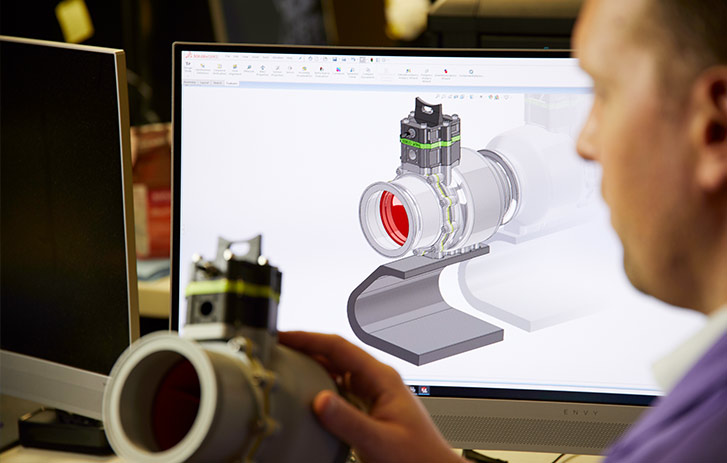![[Image: FedEx Logistics]](https://fabbaloo.com/wp-content/uploads/2020/05/fedex3dprintedparts_img_5eb09e7302a97.jpg)
3D printing is part of the FedEx vision of the future in logistics. But how much of that vision is still TBA.
Last January, FedEx joined competitors like UPS in announcing 3D printing as part of its business model. Without too many details, the company introduced FedEx Forward Depots in early 2018, offering 3D printing among inventory and service parts logistics, repair, and packaging solutions. We still don’t know too much about exactly where 3D printing, or which technologies, fit into the company’s plans — but a year later, additive manufacturing is still in the plans.
This week, FedEx announced a rebranding as FedEx Trade Networks is now FedEx Logistics. They explain:
“The new name describes the company’s ability to meet its customers’ increasingly complex and industry-specific supply chain, transportation, value-added services, and brokerage needs. FedEx Logistics provides specialty solutions that complete a simple, seamless and powerful global trade experience for FedEx customers around the world.”
Service offerings from the Memphis-headquartered FedEx Logistics include:
-
Air & Ocean Cargo Networks
-
Trade Brokerage & Facilitation
-
Custom Critical Services
-
Supply Chain Services
-
Cross Border E-Commerce & Fulfillment
-
Forward Depots & 3D Printing
Obviously it’s the last of these that drew our attention. That bullet point is really the only mention of 3D printing, though FedEx goes on to explain that:
“The capabilities within these specialty logistics service offerings include air and ocean freight forwarding, customs brokerage and international trade compliance, warehousing and transportation management, time- and temperature-controlled deliveries, critical inventory logistics, solutions for cost-effective international e-commerce trade and fulfillment, and repair and return services.”
So 3D printing fits somewhere in there, likely toward the last three points mentioned.
A statement from FedEx Logistics’ President and CEO, Richard W. Smith, notes that they offer “dynamic and customizable” solutions. Customizable and 3D printing often go hand-in-hand, suggesting a solid landing place for the technology.
3D printing is increasingly coming into the foreground as a logistics solution. It’s an area we’ve been thinking about for some time now, as industry watchers suggest the technology could disrupt (or even “transform”) logistics. The supply chain is already beginning to really feel the impact of 3D printing. It’s already been nearly a decade since the first whispers of 3D printing disrupting the business of FedEx — so incorporating the tech rather than hiding from it seems to be a solid move. Competitors (notably UPS) have already been fairly vocal about their adoption of 3D printing into operations, so it certainly makes sense for FedEx to maintain some strategic focus here.
There of course remain question marks hanging over the incorporation of 3D printing into supply chain operations. IP protection is high on this list, with several enterprises working on solutions to safeguard data when it comes to digital inventory. Spare parts 3D printing is increasingly big business, offering a more efficient means of on-demand manufacturing.
It is interesting, going back to FedEx, that the company does not detail their involvement publicly. There is exactly one result on their website for a search for “3D printing” and the extent of description is:
“3D-Printed Parts Manufacturing
Discover new options to deliver differentiated solutions with 3D printing. Contact us to learn more at [email protected]”
FedEx Forward Depot, which contains the above, has as its link description:
“Store, ship and return mission-critical parts and equipment; manufacture 3D-printed parts on demand; repair and exchange with qualified technicians.”
It could be that FedEx, like many professional users, sees 3D printing as a competitive advantage. It wasn’t until fairly recently that automotive manufacturers began being more open about the fact that they have been using 3D printing for decades. The ‘secret sauce’ approach allows for the benefits of 3D printing to be leveraged without divulging their workflow and how they might have been streamlining and speeding up development cycles.
It could also be that FedEx is still dipping its toes in the water. 3D printing is still popularly perceived as a prototyping technology rather than a viable manufacturing solution. Internally proving out a new workflow takes a lot of investment in both time and money for major operations, and for one as big as FedEx, changing from the tried-and-true would be no small feat. Adoption is a marathon, not a sprint, and announcing detailed plans before they’re truly solidified is generally ill-advised.
It could also be that the company simply hasn’t figured out yet the extent to which 3D printing will come into play for its logistics offerings. Maybe it will be important, maybe not. These two small mentions in press releases a year apart doesn’t give too much to go on, but that might be because there just isn’t an answer yet.
3D printing is coming into play for logistics solutions around the world, and will be impacting the global supply chain. At this point, that’s just a given, a fact in motion. What isn’t yet certain is the extent to which participants will each be integrating additive manufacturing, or in what form, be it through partnerships or developing in-house capabilities.
Via FedEx Logistics

